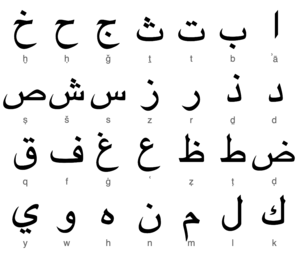
Back كتابة عربية Arabic كتابه عربى ARZ ГӀараб хъвай-хъвагӀи AV عرب خطی AZB Arapsko pismo BS Arabské písmo Czech Arabische Schrift German Araba skrib-sistemo Esperanto Escritura árabe Spanish خط عربی Persian
This article may need to be rewritten to comply with Wikipedia's quality standards. (July 2022) |
| Arabic script | |
|---|---|
 | |
| Script type | primarily, alphabet |
Time period | 4th century CE to the present[1] |
| Direction | Right-to-left script |
| Official script | 19 sovereign states Co-official script in: |
| Languages | See below |
| Related scripts | |
Parent systems | |
Child systems | N'Ko Thaana Hanifi script Persian alphabet |
| ISO 15924 | |
| ISO 15924 | Arab (160), Arabic |
| Unicode | |
Unicode alias | Arabic |
| |
The Arabic script is the writing system used for Arabic and several other languages of Asia and Africa. It is the second-most widely used alphabetic writing system in the world (after the Latin script),[2] the second-most widely used writing system in the world by number of countries using it, and the third-most by number of users (after the Latin and Chinese scripts).[3]
The script was first used to write texts in Arabic, most notably the Quran, the holy book of Islam. With the religion's spread, it came to be used as the primary script for many language families, leading to the addition of new letters and other symbols. Such languages still using it are: Persian (Farsi and Dari), Malay (Jawi), Cham (Akhar Srak),[4] Uyghur, Kurdish, Punjabi (Shahmukhi), Sindhi, Balti, Balochi, Pashto, Lurish, Urdu, Kashmiri, Rohingya, Somali, Mandinka, and Mooré, among others.[5] Until the 16th century, it was also used for some Spanish texts, and—prior to the script reform in 1928—it was the writing system of Turkish.[6]
The script is written from right to left in a cursive style, in which most of the letters are written in slightly different forms according to whether they stand alone or are joined to a following or preceding letter. However, the basic letter form remains unchanged. The script does not have capital letters.[7] In most cases, the letters transcribe consonants, or consonants and a few vowels, so most Arabic alphabets are abjads, with the versions used for some languages, such as Sorani, Uyghur, Mandarin, and Serbo-Croatian, being alphabets. It is also the basis for the tradition of Arabic calligraphy.
| Part of a series on |
| Calligraphy |
|---|
 |
- ^ Daniels, Peter T.; Bright, William, eds. (1996). The World's Writing Systems. Oxford University Press, Inc. p. 559. ISBN 978-0195079937.
- ^ "Arabic Alphabet". Encyclopædia Britannica online. Archived from the original on 26 April 2015. Retrieved 16 May 2015.
- ^ Vaughan, Don. "The World's 5 Most Commonly Used Writing Systems". Encyclopædia Britannica. Archived from the original on 29 July 2023. Retrieved 29 July 2023.
- ^ Cham romanization table background. Library of Congress
- ^ Mahinnaz Mirdehghan. 2010. Persian, Urdu, and Pashto: A comparative orthographic analysis. Writing Systems Research Vol. 2, No. 1, 9–23.
- ^ "Exposición Virtual. Biblioteca Nacional de España". Bne.es. Archived from the original on 18 February 2012. Retrieved 6 April 2012.
- ^ Ahmad, Syed Barakat. (11 January 2013). Introduction to Qur'anic script. Routledge. ISBN 978-1-136-11138-9. OCLC 1124340016.
